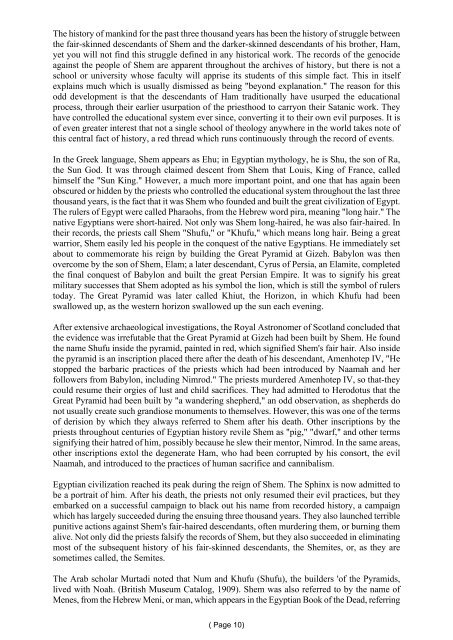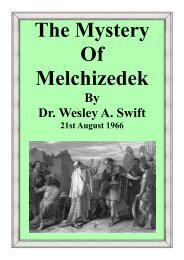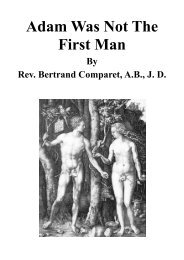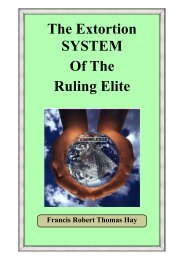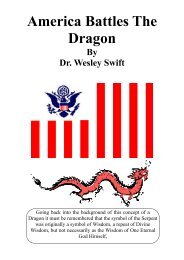Curse of Cannan - The New Ensign
Curse of Cannan - The New Ensign
Curse of Cannan - The New Ensign
Create successful ePaper yourself
Turn your PDF publications into a flip-book with our unique Google optimized e-Paper software.
<strong>The</strong> history <strong>of</strong> mankind for the past three thousand years has been the history <strong>of</strong> struggle between<br />
the fair-skinned descendants <strong>of</strong> Shem and the darker-skinned descendants <strong>of</strong> his brother, Ham,<br />
yet you will not find this struggle defined in any historical work. <strong>The</strong> records <strong>of</strong> the genocide<br />
against the people <strong>of</strong> Shem are apparent throughout the archives <strong>of</strong> history, but there is not a<br />
school or university whose faculty will apprise its students <strong>of</strong> this simple fact. This in itself<br />
explains much which is usually dismissed as being "beyond explanation." <strong>The</strong> reason for this<br />
odd development is that the descendants <strong>of</strong> Ham traditionally have usurped the educational<br />
process, through their earlier usurpation <strong>of</strong> the priesthood to carryon their Satanic work. <strong>The</strong>y<br />
have controlled the educational system ever since, converting it to their own evil purposes. It is<br />
<strong>of</strong> even greater interest that not a single school <strong>of</strong> theology anywhere in the world takes note <strong>of</strong><br />
this central fact <strong>of</strong> history, a red thread which runs continuously through the record <strong>of</strong> events.<br />
In the Greek language, Shem appears as Ehu; in Egyptian mythology, he is Shu, the son <strong>of</strong> Ra,<br />
the Sun God. It was through claimed descent from Shem that Louis, King <strong>of</strong> France, called<br />
himself the "Sun King." However, a much more important point, and one that has again been<br />
obscured or hidden by the priests who controlled the educational system throughout the last three<br />
thousand years, is the fact that it was Shem who founded and built the great civilization <strong>of</strong> Egypt.<br />
<strong>The</strong> rulers <strong>of</strong> Egypt were called Pharaohs, from the Hebrew word pira, meaning "long hair." <strong>The</strong><br />
native Egyptians were short-haired. Not only was Shem long-haired, he was also fair-haired. In<br />
their records, the priests call Shem "Shufu," or "Khufu," which means long hair. Being a great<br />
warrior, Shem easily led his people in the conquest <strong>of</strong> the native Egyptians. He immediately set<br />
about to commemorate his reign by building the Great Pyramid at Gizeh. Babylon was then<br />
overcome by the son <strong>of</strong> Shem, Elam; a later descendant, Cyrus <strong>of</strong> Persia, an Elamite, completed<br />
the final conquest <strong>of</strong> Babylon and built the great Persian Empire. It was to signify his great<br />
military successes that Shem adopted as his symbol the lion, which is still the symbol <strong>of</strong> rulers<br />
today. <strong>The</strong> Great Pyramid was later called Khiut, the Horizon, in which Khufu had been<br />
swallowed up, as the western horizon swallowed up the sun each evening.<br />
After extensive archaeological investigations, the Royal Astronomer <strong>of</strong> Scotland concluded that<br />
the evidence was irrefutable that the Great Pyramid at Gizeh had been built by Shem. He found<br />
the name Shufu inside the pyramid, painted in red, which signified Shem's fair hair. Also inside<br />
the pyramid is an inscription placed there after the death <strong>of</strong> his descendant, Amenhotep IV, "He<br />
stopped the barbaric practices <strong>of</strong> the priests which had been introduced by Naamah and her<br />
followers from Babylon, including Nimrod." <strong>The</strong> priests murdered Amenhotep IV, so that-they<br />
could resume their orgies <strong>of</strong> lust and child sacrifices. <strong>The</strong>y had admitted to Herodotus that the<br />
Great Pyramid had been built by "a wandering shepherd," an odd observation, as shepherds do<br />
not usually create such grandiose monuments to themselves. However, this was one <strong>of</strong> the terms<br />
<strong>of</strong> derision by which they always referred to Shem after his death. Other inscriptions by the<br />
priests throughout centuries <strong>of</strong> Egyptian history revile Shem as "pig," "dwarf," and other terms<br />
signifying their hatred <strong>of</strong> him, possibly because he slew their mentor, Nimrod. In the same areas,<br />
other inscriptions extol the degenerate Ham, who had been corrupted by his consort, the evil<br />
Naamah, and introduced to the practices <strong>of</strong> human sacrifice and cannibalism.<br />
Egyptian civilization reached its peak during the reign <strong>of</strong> Shem. <strong>The</strong> Sphinx is now admitted to<br />
be a portrait <strong>of</strong> him. After his death, the priests not only resumed their evil practices, but they<br />
embarked on a successful campaign to black out his name from recorded history, a campaign<br />
which has largely succeeded during the ensuing three thousand years. <strong>The</strong>y also launched terrible<br />
punitive actions against Shem's fair-haired descendants, <strong>of</strong>ten murdering them, or burning them<br />
alive. Not only did the priests falsify the records <strong>of</strong> Shem, but they also succeeded in eliminating<br />
most <strong>of</strong> the subsequent history <strong>of</strong> his fair-skinned descendants, the Shemites, or, as they are<br />
sometimes called, the Semites.<br />
<strong>The</strong> Arab scholar Murtadi noted that Num and Khufu (Shufu), the builders '<strong>of</strong> the Pyramids,<br />
lived with Noah. (British Museum Catalog, 1909). Shem was also referred to by the name <strong>of</strong><br />
Menes, from the Hebrew Meni, or man, which appears in the Egyptian Book <strong>of</strong> the Dead, referring<br />
( Page 10)


